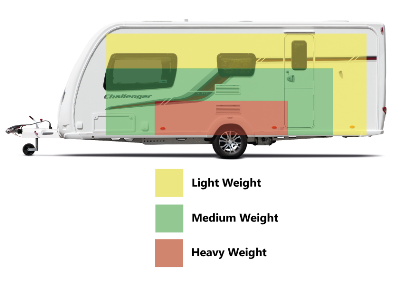Don’t throw you weight around
Everything weighs something. All those little things can add up quickly and before you know it, just like me as I place another piece of chocolate into my mouth, you and your caravan are overweight.
How did that happen, you ask? Then comes the start of the divorce procedures.
Discovering who is willing to leave things behind and who won’t?
Who will be adamant that their belongings are paramount for the trip and weigh less than yours? What usually happens is the male must have “every” tool and spare part in his shed (the “just-in-case” packing system), which can add up to a hefty amount being mainly made of metal.
The female, on the other hand, needs her full wardrobe of clothes to cater for every occasion from an outdoor hike to glamour nights out — with matching shoes and accessories naturally! Do I dare mention make-up, toiletries and all the latest gadgets for the kitchen (the “necessity” packing system)? As with everything, big and small in RVing, it all comes down to compromise. Usually, the male makes the compromise and the female gets more cupboard space.
First thing you must do is determine how much you can legally pack. Your payload (GCV, ATM, tare and ball weight). Then you need to weigh everything you load into your caravan. This includes water, gas, crockery, mattresses, TV, clothes, food, and drink – everything that is additional to the tare mass of your caravan, plus everything you have packed.
When I say additional to tare, I refer to added extras fixed on the caravan, which you probably didn’t realise were not part of the caravan’s tare weight when they came with the van, eg, gas bottles (25kg each), mattress, air conditioner, storage boxes, generator box, batteries, fuel containers, bike racks, annexe, solar panels, etc.
It is unsafe and illegal to overload your caravan, so it is important to know exactly how much you can pack on board to ensure you do not exceed the carrying capacity.
Extra weight you accumulate while travelling should also be budgeted for, eg, grey water, cassette toilet waste and the numerous items you may collect in your travels. This includes food, souvenirs, RV equipment, carton of beer/wine.
Leave enough storage space and weight allowance before departure to ensure your RV does not become overweight during your trip — easily done. A trip to your nearest public weighbridge is the final check. Have your van and car weighed fully loaded (including passengers in the car and full tank of fuel as they are part of the ATM weight allowance). Get a certificate as proof you are within the permitted limits to show any official who may stop you to check your set up.
Sensible loading — Make sure that the heaviest items are packed low and centred over the caravan’s wheel axles and the lightest items are packed up high and distributed across the vehicle. This will help to reduce the occurrence of “snaking” or “swaying” of your caravan when driving.
As a fundamental rule, caravan weight should be less than 85 per cent of the tow car’s weight. But even if you don’t surpass this threshold, your caravan may feel overloaded if you didn’t arrange your items properly.
Signs of poor packing:
- Snaking or swerving
- Tyre blowout
- Reduced brake control
- Fuel Economy
For further information, contact the WA road transport department and RV manufacturer.
Thanks to Chad for the information — http://www.AussieLifeOnWheels.com/free-issue.html



